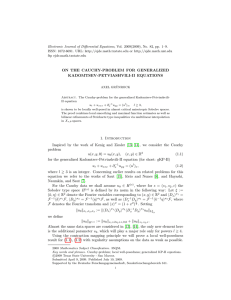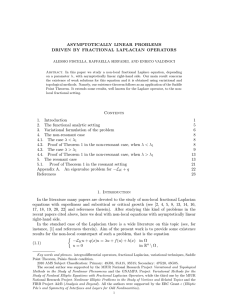Electronic Journal of Differential Equations, Vol. 2010(2010), No. 177, pp.... ISSN: 1072-6691. URL: or
advertisement
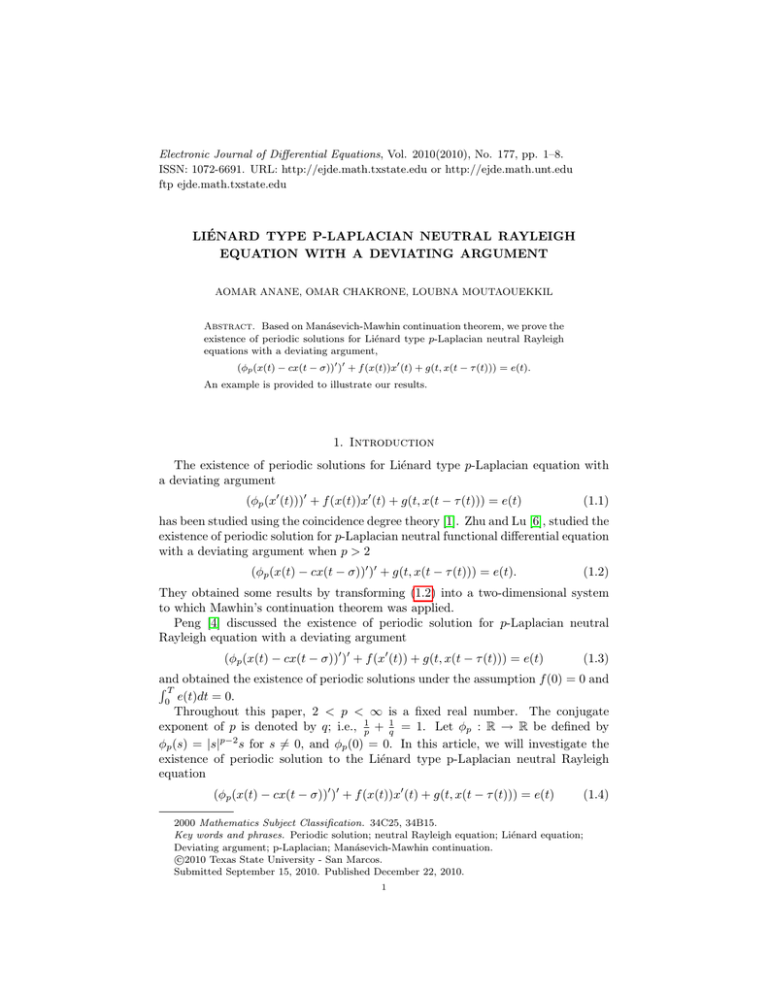
Electronic Journal of Differential Equations, Vol. 2010(2010), No. 177, pp. 1–8.
ISSN: 1072-6691. URL: http://ejde.math.txstate.edu or http://ejde.math.unt.edu
ftp ejde.math.txstate.edu
LIÉNARD TYPE P-LAPLACIAN NEUTRAL RAYLEIGH
EQUATION WITH A DEVIATING ARGUMENT
AOMAR ANANE, OMAR CHAKRONE, LOUBNA MOUTAOUEKKIL
Abstract. Based on Manásevich-Mawhin continuation theorem, we prove the
existence of periodic solutions for Liénard type p-Laplacian neutral Rayleigh
equations with a deviating argument,
(φp (x(t) − cx(t − σ))0 )0 + f (x(t))x0 (t) + g(t, x(t − τ (t))) = e(t).
An example is provided to illustrate our results.
1. Introduction
The existence of periodic solutions for Liénard type p-Laplacian equation with
a deviating argument
(φp (x0 (t)))0 + f (x(t))x0 (t) + g(t, x(t − τ (t))) = e(t)
(1.1)
has been studied using the coincidence degree theory [1]. Zhu and Lu [6], studied the
existence of periodic solution for p-Laplacian neutral functional differential equation
with a deviating argument when p > 2
(φp (x(t) − cx(t − σ))0 )0 + g(t, x(t − τ (t))) = e(t).
(1.2)
They obtained some results by transforming (1.2) into a two-dimensional system
to which Mawhin’s continuation theorem was applied.
Peng [4] discussed the existence of periodic solution for p-Laplacian neutral
Rayleigh equation with a deviating argument
(φp (x(t) − cx(t − σ))0 )0 + f (x0 (t)) + g(t, x(t − τ (t))) = e(t)
(1.3)
and obtained the existence of periodic solutions under the assumption f (0) = 0 and
RT
e(t)dt = 0.
0
Throughout this paper, 2 < p < ∞ is a fixed real number. The conjugate
exponent of p is denoted by q; i.e., p1 + 1q = 1. Let φp : R → R be defined by
φp (s) = |s|p−2 s for s 6= 0, and φp (0) = 0. In this article, we will investigate the
existence of periodic solution to the Liénard type p-Laplacian neutral Rayleigh
equation
(φp (x(t) − cx(t − σ))0 )0 + f (x(t))x0 (t) + g(t, x(t − τ (t))) = e(t)
(1.4)
2000 Mathematics Subject Classification. 34C25, 34B15.
Key words and phrases. Periodic solution; neutral Rayleigh equation; Liénard equation;
Deviating argument; p-Laplacian; Manásevich-Mawhin continuation.
c
2010
Texas State University - San Marcos.
Submitted September 15, 2010. Published December 22, 2010.
1
2
A. ANANE, O. CHAKRONE, L. MOUTAOUEKKIL
EJDE-2010/177
where f , e and τ are real continuous functions on R. τ and e are periodic with
period T , T > 0 is fixed. g is continuous function defined on R2 and T -periodic in
the first argument, c and σ are constants such that |c| =
6 1.
2. Preliminaries
Let CT = {x ∈ C(R, R) : x(t + T ) = x(t)} and CT1 = {x ∈ C 1 (R, R) : x(t + T ) =
x(t)}. CT is a Banach space endowed with the norm kxk∞ = max |x(t)|t∈[0,T ] . CT1
is a Banach space endowed with the norm kxk = max{kxk∞ , kx0 k∞ }. In what
follows, we will use k.kp to denote the LP -norm. We also define a linear operator
A : CT → CT ,
(Ax)(t) = x(t) − cx(t − σ).
Lemma 2.1 ([2, 5]). If |c| =
6 1, then A has continuous bounded inverse on CT , and
(1) kA−1 xk∞ ≤
(2)
(A
kxk∞
|1−|c|| ,
−1
for all x ∈ CT ;
(P
j
j≥0 c x(t − jσ),
x)(t) =
P
− j≥1 c−j x(t + jσ),
|c| < 1
|c| > 1.
(3)
Z
T
|(A
0
−1
1
x)(t)|dt ≤
|1 − |c||
Z
T
|x(t)|dt,
∀x ∈ CT .
0
Lemma 2.2 ([4]). If |c| =
6 1 and p > 1, then
Z T
Z T
1
|x(t)|p dt,
|(A−1 x)(t)|p dt ≤
|1 − |c||p 0
0
∀x ∈ CT .
(2.1)
x0 (0) = x0 (T ),
(2.2)
For the T -periodic boundary value problem
(φp (x0 (t)))0 = fe(t, x, x0 ),
x(0) = x(T ),
where fe ∈ C(R3 , R), we have the following result.
Lemma 2.3 ([3]). Let Ω be an open bounded set in CT1 , and let the following
conditions hold:
(i) For each λ ∈ (0, 1), the problem
(φp (x0 (t)))0 = λfe(t, x, x0 ),
x(0) = x(T ),
x0 (0) = x0 (T )
has no solution on ∂Ω.
(ii) The equation
F (a) =
1
T
Z
T
fe(t, a, 0)dt = 0
0
has no solution on ∂Ω ∩ R.
(iii) The Brouwer degree of F , deg(F, Ω ∩ R, 0) 6= 0.
Then the T -periodic boundary value problem (2.2) has at least one periodic solution
on Ω.
EJDE-2010/177
LIÉNARD TYPE EQUATION
3
3. Main results
Theorem 3.1. Suppose that p > 2 and there exist constants r1 ≥ 0, r2 ≥ 0, d > 0
and k > 0 such that
(A1) |f (x)| ≤ k + r1 |x|p−2 for x ∈ R;
(A2) x[g(t, x) − e(t)] < 0 for |x| > d and t ∈ R;
(A3) limx→−∞ |g(t,x)−e(t)|
= r2 .
|x|p−1
Then (1.4) has at least one T -periodic solution if
1
(1 + |c|)T p−1 (r1 + T r2 ) < |1 − |c||p .
p−1
2
Proof. Consider the homotopic equation of (1.4) as follows:
(φp (x(t)−cx(t−σ))0 )0 +λf (x(t))x0 (t)+λg(t, x(t−τ (t))) = λe(t),
λ ∈ (0, 1). (3.1)
We claim that the set of all possible periodic solution of (3.1) are bounded in CT1 .
Let x(t) ∈ CT1 be an arbitrary solution of (3.1) with period T . By integrating
two sides of (3.1) over [0, T ], and noticing that x0 (0) = x0 (T ), we have
Z T
[g(t, x(t − τ (t))) − e(t)]dt = 0.
(3.2)
0
By the integral mean value theorem, there is a constant ξ ∈ [0, T ] such that
g(ξ, x(ξ − τ (ξ))) − e(ξ) = 0. So from assumption (A2), we can get |x(ξ − τ (ξ))| ≤ d.
Let ξ − τ (ξ) = mT + ξ, where ξ ∈ [0, T ], and m is an integer. Then, we have
Z t
Z t
|x(t)| = |x(ξ) +
x0 (s)ds| ≤ d +
|x0 (s)|ds, t ∈ [ξ, ξ + T ],
ξ
ξ
and
Z
ξ
x0 (s)ds| ≤ d +
|x(t)| = |x(t − T )| = |x(ξ) −
t−T
Z
ξ
|x0 (s)|ds,
t ∈ [ξ, ξ + T ].
t−T
Combining the above two inequalities, we obtain
kxk∞ = max |x(t)| =
t∈[0,T ]
max |x(t)|
t∈[ξ,ξ+T ]
Z
Z ξ
n
o
1 t 0
≤ max
d+
|x (s)|ds +
|x0 (s)|ds
2 ξ
t∈[ξ,ξ+T ]
t−T
Z T
1
|x0 (s)|ds.
≤d+
2 0
In view of
that
1
p−1
(r1 + T r2 )
2p−1 (1 + |c|)T
1
2p−1
(3.3)
< |1 − |c||p , there exist a constant ε > 0 such
(1 + |c|)T p−1 (r1 + T (r2 + ε)) < |1 − |c||p .
From assumption (A3), there exist a constant ρ > d such that
|g(t, x(t − τ (t))) − e(t)|dt ≤ (r2 + ε)|x|p−1 f or t ∈ R and x < −ρ.
(3.4)
Denote E1 = {t ∈ [0, T ], x(t − τ (t)) ≤ −ρ}, E2 = {t ∈ [0, T ], |x(t − τ (t))| < ρ},
E3 = {t ∈ [0, T ], x(t − τ (t)) ≥ ρ}. By (3.2), it is easy to see that
Z
Z Z
+
+
[g(t, x(t − τ (t))) − e(t)]dt = 0.
(3.5)
E1
E2
E3
4
A. ANANE, O. CHAKRONE, L. MOUTAOUEKKIL
Hence
Z
E3
EJDE-2010/177
Z
|g(t, x(t − τ (t))) − e(t)|dt = −
[g(t, x(t − τ (t))) − e(t)]dt
E3
Z
Z =
+
[g(t, x(t − τ (t))) − e(t)]dt
E1
E2
Z
Z
≤
+
|g(t, x(t − τ (t))) − e(t)|dt.
E1
(3.6)
E2
Therefore, by (3.4) and (3.6), we obtain
Z T
Z
Z Z
|g(t, x(t − τ (t))) − e(t)|dt =
|g(t, x(t − τ (t))) − e(t)|dt
+
+
0
E1
E2
E3
Z Z
≤2
+
|g(t, x(t − τ (t))) − e(t)|dt
E1
E2
Z
≤2
(r2 + ε)|x(t − τ (t))|p−1 dt + 2e
gρ T
E1
≤ 2(r2 + ε)T kxkp−1
gρ T.
∞ + 2e
(3.7)
Where geρ = maxt∈E2 |g(t, x(t − τ (t))) − e(t)|. Multiplying both sides of (3.1) by
(Ax)(t) = x(t) − cx(t − σ) and integrating them over [0, T ], we have
Z T
kAx0 kpp = λ
(Ax)(t) [f (x(t))x0 (t) + g(t, x(t − τ (t))) − e(t)] dt
0
(3.8)
Z T
[|f (x(t))x0 (t)| + |g(t, x(t − τ (t))) − e(t)|] dt.
≤ (1 + |c|)kxk∞
0
From assumption (A1), we obtain.
Z T
Z
0
|f (x(t))x (t)|dt ≤ k
0
0
T
0
Z
|x (t)|dt + r1
T
|x0 (t)||x(t)|p−2 dt.
(3.9)
0
Using Hölder inequality, and substituting (3.3) into (3.9), we obtain
Z
Z T
p−2
1 T 0
|x (t)|dt
. (3.10)
|f (x(t))x0 (t)|dt ≤ kT 1/q kx0 kp + r1 T 1/q kx0 kp d +
2 0
0
From (3.3) and (3.7), we have
Z T
Z
p−1
1 T 0
|x (t)|dt
. (3.11)
|g(t, x(t − τ (t))) − e(t)|dt ≤ 2 geρ T + 2(r2 + ε)T d +
2 0
0
Substituting (3.10), (3.11) and (3.3) into (3.8), we obtain
kAx0 kpp
Z
h
1 T 0
|x (t)|dt
≤ (1 + |c|) kT 1/q kx0 kp d +
2 0
Z T
p−1
1
+ d+
|x0 (t)|dt
r1 T 1/q kx0 kp
2 0
Z
Z
p
i
1 T 0
1 T 0
+ 2(r2 + ε)T d +
|x (t)|dt + 2e
gρ T d +
|x (t)|dt .
2 0
2 0
RT 0
Case(1). If 0 |x (t)|dt = 0, from (3.3), we have kxk∞ < d.
(3.12)
EJDE-2010/177
LIÉNARD TYPE EQUATION
Case(2). If
d+
1
2
Z
RT
0
5
|x0 (t)|dt > 0, then
T
|x0 (t)|dt
p−1
=
0
1 Z
2
T
|x0 (t)|dt
p−1 0
1+ RT
0
2d
p−1
|x0 (t)|dt
.
(3.13)
By elementary analysis, there is a constant δ > 0 such that
(1 + u)p−1 ≤ 1 + pu, ∀u ∈ [0, δ].
(3.14)
RT 0
RT 0
If 2d/ 0 |x (t)|dt > δ, then 0 |x (t)|dt < 2d/δ, so from (3.3), we have kxk∞ <
d + (d/δ).
RT
If 2d/ 0 |x0 (t)|dt ≤ δ, by (3.13) and (3.14),
Z
p−1
1 T 0
|x (t)|dt
d+
2 0
1 Z T
p−1 2pd
≤
|x0 (t)|dt
1+ RT
2 0
|x0 (t)|dt
0
Z T
Z
p−2
p−1
1 p−1
1 p−2 T 0
≤
|x0 (t)|dt
+
pd
|x (t)|dt
2
2
0
0
p−2
1 p−1 p−1
1
p−2
T q kx0 kp−1
pdT q kx0 kp−2
≤
+
.
p
p
2
2
(3.15)
Similarly, from(3.14), there is a constant δ 0 > 0 such that
(1 + u)p ≤ 1 + (1 + p)u, ∀u ∈ [0, δ 0 ]
(3.16)
RT 0
R
T
If 2d/ 0 |x (t)|dt > δ 0 , then 0 |x0 (t)|dt < 2d/δ 0 , so from (3.3), we have kxk∞ <
0
d + (d/δ ).
RT
If 2d/ 0 |x0 (t)|dt ≤ δ 0 , by (3.16), we have
Z
p
1 T 0
d+
|x (t)|dt
2 0
1 Z T
p 2(p + 1)d ≤
|x0 (t)|dt
1+ RT
2 0
|x0 (t)|dt
0
Z T
Z T
p−1
p
1 p
1 p−1
|x0 (t)|dt +
(p + 1)d
|x0 (t)|dt
≤
2
2
0
0
p−1
1 p pq 0 p
1 p−1
0 p−1
q
≤
T kx kp +
(p + 1)dT
kx kp .
2
2
(3.17)
Substituting (3.15) and (3.17) into (3.12) and using Hölder inequality, we obtain
kAx0 kpp ≤ (1 + |c|)[(
1
2p−1
(r2 + ε)T p +
1
r1 T
2p−1
p
q
)kx0 kpp + a0 kx0 kp−1
p
(3.18)
+ a1 kx0 k2p + a2 kx0 kp + 2e
gρ T d],
where a0 , a1 and a2 are constants depending on T, r1 , k, r2 , d, p and c. Then from
Lemma(2.2), we have
|1 − |c||p kx0 kpp = |1 − |c||p kA−1 Ax0 kpp ≤ kAx0 kpp .
6
A. ANANE, O. CHAKRONE, L. MOUTAOUEKKIL
EJDE-2010/177
So it follows from (3.18) that
|1 − |c||p kx0 kpp ≤ (1 + |c|)[(
1
2p−1
T p−1 (r1 + T (r2 + ε)))kx0 kpp + a0 kx0 kp−1
p
(3.19)
+ a1 kx0 k2p + a2 kx0 kp + 2e
gρ T d].
As p > 2 and
such that
1
p−1
(r1 + T r2 )
2p−1 (1 + |c|)T
< |1 − |c||p , there exists a constant R3 > 0
kx0 kp ≤ R3 .
(3.20)
Which together with (3.3) implies that there is a positive number R4 such that
kxk∞ ≤ R4 .
(3.21)
From (3.1), we have
Z T
|(φp (Ax0 )(t))0 |dt
0
Z
T
≤
[|f (x(t))x0 (t)| + |g(t, x(t − τ (t))) + |e(t)|]dt
0
≤ kT 1/q kx0 kp +
Z
T
r1 |x|p−2 |x0 (t)| + T gR4 +
0
≤ kT
1/q
0
kx kp +
T
Z
|e(t)|dt
(3.22)
0
p−2 1/q
r1 kxk∞
T kx0 kp
Z
T
|e(t)|dt
+ T gR4 +
0
≤ kT 1/q R3 + r1 R4p−2 T 1/q R3 + T gR4 +
Z
T
|e(t)|dt = R5 ,
0
where gR4 = max|x|≤R4 ,t∈[0,T ] |g(t, x(t−τ (t)))|. As (Ax)(0) = (Ax)(T ), there exists
t0 ∈]0, T [ such that (Ax0 )(t0 ) = 0, while φp (0) = 0 we see φp (Ax0 )(t0 ) = 0. Thus,
for any t ∈ [0, T ], we have
Z t
Z T
0
0
|φp (Ax )(t))| = |
φp (Ax )(s))ds| ≤
|(φp (Ax0 )(s))0 |dt ≤ R5 .
t0
0
From which, it follows that
kAx0 k∞ ≤ R5q−1 .
(3.23)
From Lemma 2.1, we derive
kx0 k∞ = kA−1 Ax0 k∞ ≤
kAx0 k∞
R5q−1
≤
= R6 .
|1 − |c||
|1 − |c||
(3.24)
Now, let y(t) = (Ax)(t), we can see that (3.1) is equivalent to the equation
(φp (y 0 (t)))0 + λf ((A−1 y)(t))(A−1 y 0 )(t) + λg(t, (A−1 y)(t − τ (t))) = λe(t). (3.25)
So, if y is an periodic solution of (3.25), then x = A−1 y is T -periodic solution of
(3.1).
Let R7 = 2(1 + |c|) max{R4 , R6 , d}, Ω = {y ∈ CT1 : kyk < R7 }, we can see
that (3.25) has no solution on ∂Ω for λ ∈ (0, 1). In fact, if y = Ax is a solution
(3.25) on ∂Ω, then kyk = R7 , kyk∞ = R7 or ky 0 k∞ = R7 . If kyk∞ = R7 , then
∞
kxk∞ ≥ kyk
1+|c| = 2 max{R4 , R6 , d} > R4 , from (3.21) which is a contradiction.
EJDE-2010/177
LIÉNARD TYPE EQUATION
7
Similarly, ky 0 k∞ = R7 is also impossible. If y ∈ ∂Ω ∩ R, then y is a constant and
y
, |x| ≥ 2 max{R4 , R6 , d}. Let
|y| = R7 , x = A−1 y = 1−c
Z T
1
F (y) =
[e(t) − f ((A−1 y)(t))(A−1 y 0 )(t) − g(t, (A−1 y)(t − τ (t)))].
T 0
RT
y
Then F (y) = T1 0 [e(t) − g(t, 1−c
)]dt for y ∈ ∂Ω ∩ R. From (A2), we know that
F (y) 6= 0 on ∂Ω ∩ R, so condition (ii) in Lemma 2.3 is satisfied. Define
H(y, µ) = µ(A−1 y) + (1 − µ)F (y),
y ∈ ∂Ω ∩ R, µ ∈ [0, 1]. Then
(−A−1 y)H(y, µ) = −µ(A−1 y)2 −(1−µ)(A−1 y)
1
T
Z
T
[e(t)−g(t, (A−1 y)(t−τ (t)))]dt.
0
From (A2) we obtain (A−1 y)H(y, µ) > 0. Thus H(y, µ) is a homotopic transformation and deg[F, Ω ∩ R, 0] = deg[A−1 y, Ω ∩ R, 0] 6= 0. So, for (3.25), all of conditions
of Lemma 2.3 are satisfied. Applying Lemma 2.3, we conclude that
(φp (y 0 (t)))0 + f ((A−1 y)(t))(A−1 y 0 )(t) + g(t, (A−1 y)(t − τ (t))) = e(t)
−1
has at least one T -periodic solution y. Therefore, x = A
solution of (1.4).
(3.26)
y is an T -periodic
Similarly, we can prove the following Theorem.
Theorem 3.2. Suppose that p > 2 and that there exist constants r1 ≥ 0, r2 ≥ 0,
d > 0 and k > 0 such that
(A1) |f (x)| ≤ k + r1 |x|p−2 for x ∈ R;
(A2) x[g(t, x) − e(t)] < 0 for |x| > d and t ∈ R;
(A3) limx→+∞ |g(t,x)−e(t)|
= r2 .
|x|p−1
then (1.4) has at least one T -periodic solution if
1
(1 + |c|)T p−1 (r1 + T r2 ) < |1 − |c||p .
2p−1
4. Example
In this section, we illustrate Theorem 3.1 with the following example. Consider
the equation
2
(φ3 (x(t) − 5x(t − π))0 )0 + f (x(t))x0 (t) + g(t, x(t − sin(t))) = ecos t ,
2
(4.1)
√
|x|
where p = 3, c = 5, σ = 4, T = 2π, τ (t) = sin t, e(t) = ecos t , f (x) = 2 + π2 ,
(
2
−xesin t , x ≥ 0
g(t, x) =
x2
x < 0.
18π 2 ,
√
max|x|≤1 |f (x)|
1
Let d = 3π 2e, r1 = π12 , r2 = 18π
. We can easily check the
2, k = 4+
π2
condition (A1), (A2) and (A3) of Theorem 3.1 hold. Furthermore,
2π
1
(1 + |c|)T p−1 (r1 + T r2 ) = 6 +
< |1 − |c||p = 64.
2p−1
3
By Theorem 3.1, (4.1) has at least one 2π-periodic solution.
8
A. ANANE, O. CHAKRONE, L. MOUTAOUEKKIL
EJDE-2010/177
References
[1] B. Liu; Periodic solutions for Liénard type p-Laplacian equation with a deviating arguments,
Journal of Computational and Applied Mathematics 214(2008), 13-18.
[2] S. P. Lu, J. Ren, W. Ge; Problems of periodic solutions for a kind of second order neutral
functional differential equations, Appl. Anal. Appl. 82(5)(2003), 393-410.
[3] R. Manásevich, J. Mawhin; Periodic solutions for nonlinear systems with p-Laplacian-like
operators, J. Differential Equations 145(1998), 367-393.
[4] S. Peng; Periodic solutions for p-Laplacian neutral Rayleigh equation with a deviating arguments, Nonlinear Analysis 69(2008), 1675-1685.
[5] M. R. Zhang; Periodic solutions to linear and quasilinear neutral functional differential equation, J. Math. Anal. Appl. 189(1995), 378-392.
[6] Y. L. Zhu, S. P. Lu; Periodic solutions for p-Laplacian neutral functional differential equation
with deviating arguments, J. Math. Anal. Appl. 325(2007), 377-385.
Université Mohamed I, Faculté des Sciences, Département de Mathématiques et Informatique, Oujda, Maroc
E-mail address, Aomar Anane: anane@sciences.univ-oujda.ac.ma
E-mail address, Omar Chakrone: chakrone@yahoo.fr
E-mail address, Loubna Moutaouekkil: loubna anits@yahoo.fr
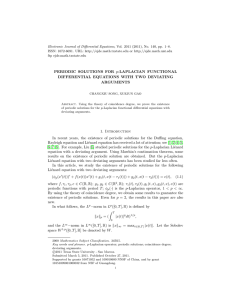
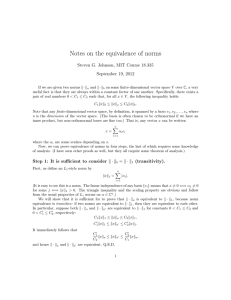

![MA3422 (Functional Analysis 2) Tutorial sheet 5 [February 20, 2015] Name: Solutions](http://s2.studylib.net/store/data/010731574_1-a234d4f791b0e409f7fde88583c6137c-300x300.png)

